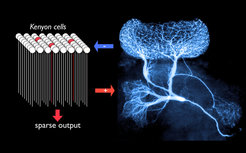A giant interneuron for sparse coding
A single interneuron controls activity adaptively in 50,000 neurons, enabling consistently sparse codes for odours

A single "giant", non-spiking, GABAergic interneuron (right, labelled by intracellular injection of fluorescent dye) forms an all-to-all negative feedback loop with a population of about 50,000 Kenyon cells, principal neurons of the mushroom bodies, a structure involved in olfactory memory in the insect brain. This normalizing feedback loop serves to ensure relatively constant sparseness of mushroom body output across varying input strengths. Sparseness is an important feature of sensory representations in areas involved in memory formation.
The brain is a coding machine: it translates physical inputs from the world into visual, olfactory, auditory, tactile perceptions via the mysterious language of its nerve cells and the networks which they form. Neural codes could in principle take many forms, but in regions forming bottlenecks for information flow (e.g., the optic nerve) or in areas important for memory, sparse codes are highly desirable.
Scientists at the Max Planck Institute for Brain Research in Frankfurt have now discovered a single neuron in the brain of locusts that enables the adaptive regulation of sparseness in olfactory codes. This single giant interneuron tracks in real time the activity of several tens of thousands of neurons in an olfactory centre and feeds inhibition back onto all of them, so as to maintain their collective output within an appropriately sparse regime. In this way, representation sparseness remains steady as input intensity or complexity varies.












